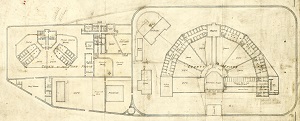A PLAN OF GALWAY GAOL, 1866

by Tom Kenny
In 1578, the charter of Queen Elizabeth granted full power to the Corporation “to have forever a gaol within the town, and a keeper of the same, and to commit to, and imprison therein prisoners for whatever cause they should be taken, attached or arrested”.
The original prison was in a small room under the Tholsel, and later in Blake’s Castle, but they became too small so a new prison was built at a place called the Main Guard. Apart from its bad construction, inconvenience and lack of accommodation, it blocked one of the main entrances to the town, so in 1802, the Corporation decided, for the purpose of widening the street, to demolish the existing gaol and guard house and build a new one.
On this day, the 27th of December in 1810, the new County Gaol opened and took in its first prisoners. It held 180 prisoners in eight wards. No timber was used in its construction, everything consisted of stone and iron. It was 3 storeys high, described as a very handsome building in the form of a crescent, vaulted throughout. The basement housed the keeper and his family. Debtors occupied rooms along the entire front of the building. Behind these rooms, at the end of a large hall, was an iron door leading to a double row of cells with a yard at the back. A flight of stone stairs led to the 2nd floor containing a row of arched cells corresponding to those underneath. The 3rd floor had cells for solitary confinement of ‘incorrigible felons’. The foundation stone for the Town Gaol was laid in 1807 and it opened shortly after the County Gaol.
A correspondent writing in 1882 said, “Here is the cell accommodation for the suspects in Galway Gaol – 33 out of 74 are provided with good cells i.e. 15 ft. by 6ft. by about 8ft. high, but 12 of these cells are on the ground floor where the surrounding walls shut out even that modicum of light and air which the cells on a higher floor enjoy. The remaining cells are only 6ft x 6ft and only 8ft in height. The prisoner’s bed which extends from wall to wall, occupies just half the cell. A small table and chair claim a portion of the remaining space, and the balance, about 3ft. square, is devoted to whatever perambulations the prisoner may choose to indulge in during 9 hours out of 18. One prisoner dealt with the problem as follows ‘I place my chair, table, books and clothes on my bed and this gives me six feet of a walking track, but instead of pacing, I foot it, lest I may have a headache from turning so often’. Some of the cells are not provided with a small trap-door through which a drink of water may be handed in. Some are lighted at night by a gas jet over which the prisoner has no control, for the cock which regulates each light is outside the cell. Should the light be blown out, as very often happens, the gas sis pouring in on the prisoner until he has succeeded in calling a warder”.
The two jails were amalgamated in the 1870’s. By the 1920’s, there were a lot of complaints about sanitary conditions in the gaol due largely to overcrowding and the lack of cleanliness. “If something is not done quickly, there is a grave danger of an outbreak of zymotic disease”. The gaol closed in 1939 and is now the site of Galway Cathedral.
This plan is dated 1866 and is one of the 13 items listed in “County and County of the Town of Galway Gaol, plans and drawings, 1830-1866” file which can be found online at www.galway.ie/archives. They are part of the Galway County Council archives which are based in Cathedral Square under the watchful eye of Patria McWalter, and are a treasure trove for anyone researching or simply interested in the history of Galway. Be sure to visit it online to get an idea of what is available there.
Finally, a note of thanks to all those who contributed to this column over the past year in the form of photographs, information, suggestions, criticism or just plain slaggin’. Go raibh maith agaibh. Blian Nua fé shéan is fé mhaise díbh uilig.
